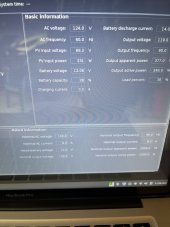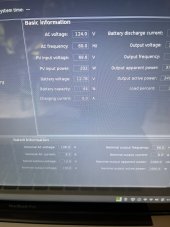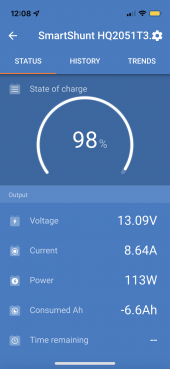Hey all,
I've been playing around testing a new PIP-1012LV-MS...
It is having a problem reading an accurate voltage from the battery. I have it connected to a 100AH Zooms battery and AC input (No solar at this time). I'm using all of Will's settings (except I changed the voltage switchover to/from AC range from Will's recommended 11.5v and 12.25v to 12.3 and 13.5).
If just sitting charging and not providing a load the voltage reading on the unit is "close" to the voltage reading on my Ali Meter.(within 2-3 tenths). I also read the same voltage with my multimeter at both the battery terminals and at the connection to the PIP. (again within 1-2 tenths)
However, the problem is when the unit is providing a load. (In my case about 80 watts). The voltage reading on the PIP is about 8-9 tenths lower. For example, last night I let the PIP charge the battery fully to 100%. This evening, I turned everything on and started powering the same 80 watt load. The voltage on my Ali meter is reading 13.3v. My multimeter reads about the same at both the battery terminals and the PIP terminals. But, the PIP is showing only 12.4v. This in turn is flashing a low battery warning on the display and then eventually switches over to AC Bypass when in fact my battery is still about 99% charged?!?!?! I guess the switchover to AC makes sense based on my settings since it thinks the voltage dropped to 12.3. But, why is the voltage reading so low?
After a few minutes, now the PIP voltage is showing 13.8v, the charger is in float mode (according to the solid green charging light), load is still being supplied by Bypass AC power, and the actual voltage at the terminals is only 13.3???
Can anyone shed some light on what is going on?
Thanks,
Jeff
I've been playing around testing a new PIP-1012LV-MS...
It is having a problem reading an accurate voltage from the battery. I have it connected to a 100AH Zooms battery and AC input (No solar at this time). I'm using all of Will's settings (except I changed the voltage switchover to/from AC range from Will's recommended 11.5v and 12.25v to 12.3 and 13.5).
If just sitting charging and not providing a load the voltage reading on the unit is "close" to the voltage reading on my Ali Meter.(within 2-3 tenths). I also read the same voltage with my multimeter at both the battery terminals and at the connection to the PIP. (again within 1-2 tenths)
However, the problem is when the unit is providing a load. (In my case about 80 watts). The voltage reading on the PIP is about 8-9 tenths lower. For example, last night I let the PIP charge the battery fully to 100%. This evening, I turned everything on and started powering the same 80 watt load. The voltage on my Ali meter is reading 13.3v. My multimeter reads about the same at both the battery terminals and the PIP terminals. But, the PIP is showing only 12.4v. This in turn is flashing a low battery warning on the display and then eventually switches over to AC Bypass when in fact my battery is still about 99% charged?!?!?! I guess the switchover to AC makes sense based on my settings since it thinks the voltage dropped to 12.3. But, why is the voltage reading so low?
After a few minutes, now the PIP voltage is showing 13.8v, the charger is in float mode (according to the solid green charging light), load is still being supplied by Bypass AC power, and the actual voltage at the terminals is only 13.3???
Can anyone shed some light on what is going on?
Thanks,
Jeff







